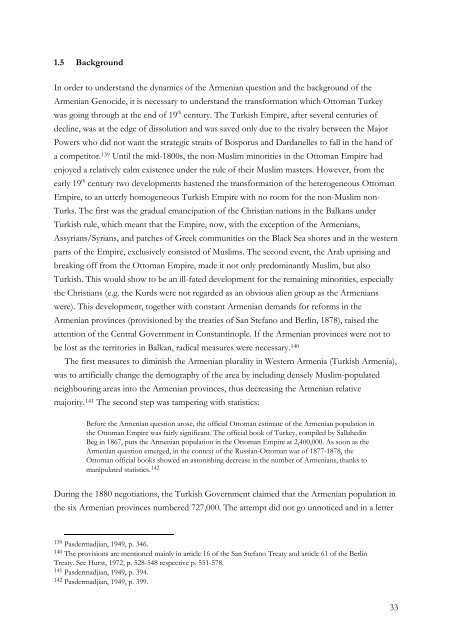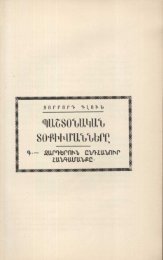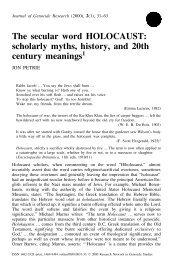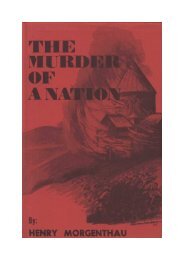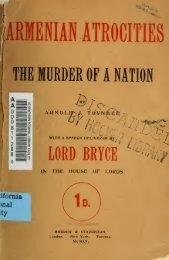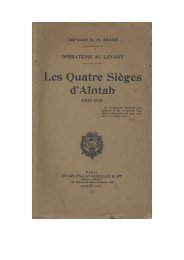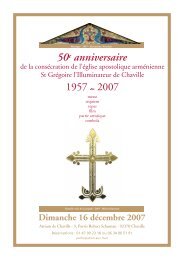Utrikesdepartementet 1920 års dossiersystem, containing all Swedish dipl<strong>om</strong>atic correspondence andinformation (everything fr<strong>om</strong> data regarding embassy personnel, their wages and reports totreaties, statistics and intelligence data, and collected newspaper clips) pertaining to internationaland foreign relations, but especially fr<strong>om</strong> all Swedish foreign representations around the globe.The first series cover mainly the period of 1902-1919, while the second series cover the periodbetween 1920 and 1970. In total they constitute over 15,000 volumes of information and data.In order to broaden the view of the decision making, the protocols of the Swedish Parliament,the Riksdag, was studied to find out about any documented debates in regard to the ongoingmassacres. Furthermore, the c<strong>om</strong>muniqués with the League of Nations and decisions made bythe League have also been consulted. Most of the information regarding the League has beenfound in the organisation’s publication, Official Journal, and in the Assembly Protocols.If any of the previous information (newspapers, missionary, and military reports) are regardedas important, the dipl<strong>om</strong>atic reports by the Swedish Ambassador must be regarded as the mostreliable information, at least fr<strong>om</strong> the Swedish Government’s point of view. The SwedishEmbassy both functioned as the provider of information and analysed the gathered information.It was these reports that provided the data bed, requested instructions upon observations, andrec<strong>om</strong>mended certain actions in regard to the Swedish foreign policy. Thus, the contents of thereports dispatched by the Swedish Embassy are a reliable source for how official Stockholmperceived the Armenian massacres, what measures the Ambassador was instructed to take or herec<strong>om</strong>mended Stockholm to do.It is worth mentioning that, unlike Wirsén, there are no indications whether or not theSwedish Ambassador during the period between 1915 and 1920, Cosswa Anckarsvärd, did travelaround in the Ott<strong>om</strong>an Empire, acquiring the information he dispatched to Sweden. In s<strong>om</strong>ereport it is mentioned that the source of his information are published news in the country,letters or intelligence information fr<strong>om</strong> his German counterpart or other dipl<strong>om</strong>atic missions inand outside Turkey. This will be indicated where the sources are mentioned explicitly.Notwithstanding, an Ambassador such as Anckarsvärd must have had a broad contact net,including Turkish officials, opposition members, foreign dipl<strong>om</strong>ats and representatives, <strong>min</strong>orityrepresentatives etc. who supplied him with a range of information about the situation in theEmpire, thus providing him with a satisfactory amount of data to base his analysis upon.All documents mentioning the situation of the Armenian population, its treatment during themassacres and deportations, and later in regard to the post-war discussions about the creation ofan Armenian state have been considered. Reports regarding other Christian people in Ott<strong>om</strong>anTurkey and similar treatment as that towards the Armenians have been included to depict theongoing Turkish state policy towards <strong>min</strong>orities. As it will be shown later, both kinds ofdocuments, confir<strong>min</strong>g as well as denying the Armenian massacres, have been included in thestudy and will display how and when the break point in the nature of the reporting begins, underwhat pretext the denial is implemented and its real agenda.32
1.5 BackgroundIn order to understand the dynamics of the Armenian question and the background of theArmenian Genocide, it is necessary to understand the transformation which Ott<strong>om</strong>an Turkeywas going through at the end of 19 th century. The Turkish Empire, after several centuries ofdecline, was at the edge of dissolution and was saved only due to the rivalry between the MajorPowers who did not want the strategic straits of Bosporus and Dardanelles to fall in the hand ofa c<strong>om</strong>petitor. 139 Until the mid-1800s, the non-Muslim <strong>min</strong>orities in the Ott<strong>om</strong>an Empire hadenjoyed a relatively calm existence under the rule of their Muslim masters. However, fr<strong>om</strong> theearly 19 th century two developments hastened the transformation of the heterogeneous Ott<strong>om</strong>anEmpire, to an utterly h<strong>om</strong>ogeneous Turkish Empire with no ro<strong>om</strong> for the non-Muslim non-Turks. The first was the gradual emancipation of the Christian nations in the Bal<strong>kan</strong>s underTurkish rule, which meant that the Empire, now, with the exception of the Armenians,Assyrians/Syrians, and patches of Greek c<strong>om</strong>munities on the Black Sea shores and in the westernparts of the Empire, exclusively consisted of Muslims. The second event, the Arab uprising andbreaking off fr<strong>om</strong> the Ott<strong>om</strong>an Empire, made it not only predo<strong>min</strong>antly Muslim, but alsoTurkish. This would show to be an ill-fated development for the remaining <strong>min</strong>orities, especiallythe Christians (e.g. the Kurds were not regarded as an obvious alien group as the Armenianswere). This development, together with constant Armenian demands for reforms in theArmenian provinces (provisioned by the treaties of San Stefano and Berlin, 1878), raised theattention of the Central Government in Constantinople. If the Armenian provinces were not tobe lost as the territories in Bal<strong>kan</strong>, radical measures were necessary. 140The first measures to di<strong>min</strong>ish the Armenian plurality in Western Armenia (Turkish Armenia),was to artificially change the demography of the area by including densely Muslim-populatedneighbouring areas into the Armenian provinces, thus decreasing the Armenian relativemajority. 141 The second step was tampering with statistics:Before the Armenian question arose, the official Ott<strong>om</strong>an estimate of the Armenian population inthe Ott<strong>om</strong>an Empire was fairly significant. The official book of Turkey, c<strong>om</strong>piled by SallahedinBeg in 1867, puts the Armenian population in the Ott<strong>om</strong>an Empire at 2,400,000. As soon as theArmenian question emerged, in the context of the Russian-Ott<strong>om</strong>an war of 1877-1878, theOtt<strong>om</strong>an official books showed an astonishing decrease in the number of Armenians, thanks t<strong>om</strong>anipulated statistics. 142During the 1880 negotiations, the Turkish Government claimed that the Armenian population inthe six Armenian provinces numbered 727,000. The attempt did not go unnoticed and in a letter139 Pasdermadjian, 1949, p. 346.140 The provisions are mentioned mainly in article 16 of the San Stefano Treaty and article 61 of the BerlinTreaty. See Hurst, 1972, p. 528-548 respective p. 551-578.141 Pasdermadjian, 1949, p. 394.142 Pasdermadjian, 1949, p. 399.33
- Page 3 and 4: 1 Introduction.....................
- Page 5 and 6: War, rather confirm the version of
- Page 7 and 8: 1.2 Previous ResearchWhen discussin
- Page 9 and 10: Military Attaché and the missionar
- Page 11 and 12: situation: “It is a crime when Te
- Page 13 and 14: in the following investigation, whi
- Page 15 and 16: killed. The slaughterer slaughtered
- Page 17 and 18: interests. Despite his famous “14
- Page 19 and 20: morality, balance of power, or the
- Page 21 and 22: 4. International organisations (e.g
- Page 23 and 24: warring parties. 104 This observati
- Page 25 and 26: Concerning the protocols of the Swe
- Page 27 and 28: present in Turkey. These documents
- Page 29 and 30: He also mentions meeting an Armenia
- Page 31: the annihilation. General von Losso
- Page 35 and 36: 1914, when two inspector-generals f
- Page 37 and 38: to Islam or were sold as slaves to
- Page 39 and 40: 2 Empirical AnalysisThe empirical r
- Page 41 and 42: It does not seem to be the Turkish
- Page 43 and 44: The Turks claim that, at the Russia
- Page 45 and 46: The Armenian population has equippe
- Page 47 and 48: 1917 was the revival year for the A
- Page 49 and 50: Even if the communication between t
- Page 51 and 52: implemented against the Armenian na
- Page 53 and 54: Anckarsvärd continued claiming tha
- Page 55 and 56: Germany is blamed for its accessory
- Page 57 and 58: Here Wirsén took the liberty to co
- Page 59 and 60: On February 19, news of new Armenia
- Page 61 and 62: estricted to the fields of intrigue
- Page 63 and 64: generous offer of President Wilson
- Page 65 and 66: Lange gave a detailed description o
- Page 67 and 68: skin was totally scorched. Another
- Page 69 and 70: which her recurrently emphasised th
- Page 71 and 72: The sooner calls referring to the A
- Page 73 and 74: Despite these facts, Armenia was th
- Page 75 and 76: Svenska Riksarkivet [Swedish Nation
- Page 77 and 78: Bakhtiari, Kalla det vad fan du vil
- Page 79 and 80: Chan, Steve and Drury, Cooper A., S
- Page 81 and 82: Moranian, Suzanne Elizabeth, Bearin


